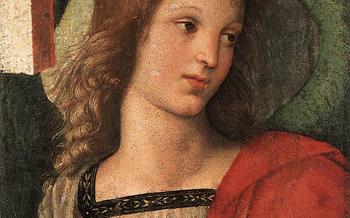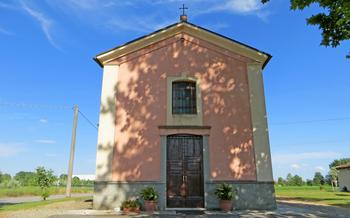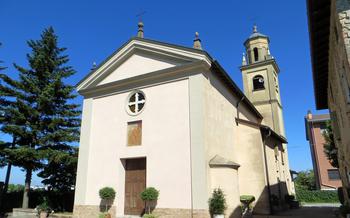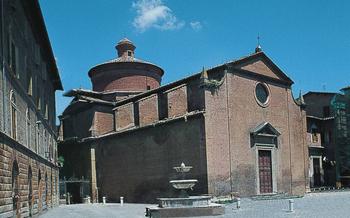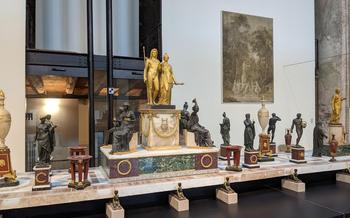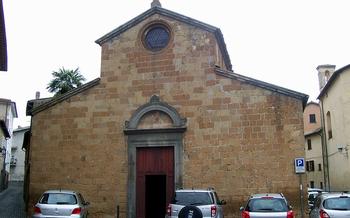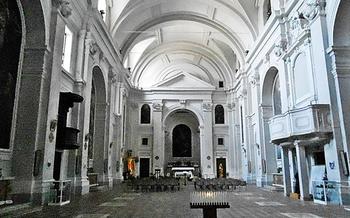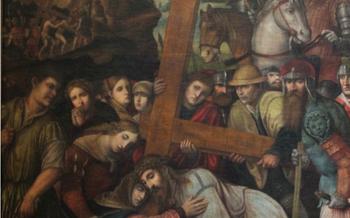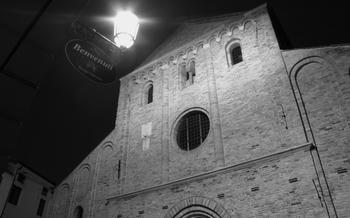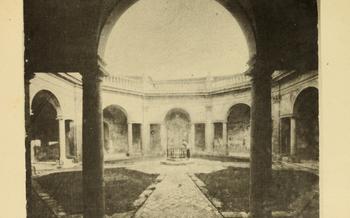
Chiesa di San Paolo
- Introduction – Chiesa di San Paolo: A Sanctuary of Artistic Marvels
- Façade Intricacies - Unveiling the Stories in Stone
- The Correggio Masterpiece - A Glimpse into Renaissance Brilliance
- Treasury of Frescoes - Uncovering Hidden Masterpieces
- Renaissance Architecture - Exploring the Structural Grandeur
- Baroque Additions - A Touch of Opulence and Drama
- Altarpieces and Sculptures - A Symphony of Sacred Art
- Exploring the Crypt - A Journey into the Past
- Historical Importance as a Pilgrimage Site
- Visiting Information - Practical Tips for Your Pilgrimage
- Local Events and Celebrations - Immerse Yourself in the Tradition
- Nearby Attractions - Discover Parma's Treasures
- Gastronomic Delights - Savoring the Flavors of Parma
- Accommodation and Hotels - Finding Your Perfect Stay
- Insider Tip - Unforgettable Views and Tranquility
Introduction – Chiesa di San Paolo: A Sanctuary of Artistic Marvels
Amidst the vibrant city of Parma, Italy, stands a treasure trove of artistic wonders – the Chiesa di San Paolo. Built in the 10th century and rebuilt in the 15th century, this awe-inspiring church embodies the spirit of Renaissance and Baroque eras, captivating visitors with its architectural grandeur and exquisite artistic masterpieces.
Located in the heart of Parma's historic center, the Chiesa di San Paolo boasts an impressive façade adorned with intricate carvings and symbolic sculptures. Inside, the sanctuary unveils a breathtaking array of frescoes, altarpieces, and sculptures that narrate biblical stories and showcase the virtuosity of renowned artists like Correggio.
As a significant pilgrimage site, the church holds a profound spiritual significance for devotees of Saint Paul. Its rich history, artistic splendor, and spiritual essence make it a must-visit destination for art enthusiasts, pilgrims, and travelers seeking cultural immersion in Parma.
Façade Intricacies - Unveiling the Stories in Stone
The façade of the Chiesa di San Paolo stands as a testament to the artistry and symbolism that permeate the Renaissance era. Constructed in the 15th century, it showcases a harmonious blend of Gothic and Renaissance architectural styles. The lower portion exhibits Gothic influences, with pointed arches and intricate tracery that lend a sense of upward movement. In contrast, the upper section embraces the classical ideals of the Renaissance, featuring a pediment, pilasters, and a central oculus that floods the interior with natural light.
Symbolism and imagery are woven into every element of the façade. The central portal is adorned with sculptures depicting scenes from the life of Saint Paul, the church's namesake. These intricate carvings serve as a visual narrative, inviting visitors to contemplate the saint's journey and teachings. Above the portal, a rose window radiates with colorful stained glass, casting a kaleidoscope of light into the church's interior. The window's intricate design depicts the Virgin Mary surrounded by angels, symbolizing the divine presence that permeates the sacred space.
The historical context of the façade's construction adds depth to its significance. Built during a period of great cultural and intellectual flourishing in Parma, the church reflects the city's embrace of the Renaissance ideals. The façade's harmonious blend of Gothic and Renaissance elements mirrors the transition that was taking place in the city's artistic and cultural landscape, making it a tangible representation of Parma's rich history and heritage.
The Correggio Masterpiece - A Glimpse into Renaissance Brilliance
Born in 1489, Antonio Allegri da Correggio, known simply as Correggio, ascended as one of the most influential and innovative painters of the Italian Renaissance. His contributions to art, particularly in the realm of illusionistic ceiling frescoes, left an enduring legacy.
Within the Chiesa di San Paolo, Correggio's genius is showcased in the awe-inspiring fresco titled "The Assumption of the Virgin." Crafted between 1526 and 1530, it adorns the church's apse, captivating viewers with its harmonious blend of naturalism and the divine.
The fresco portrays the Virgin Mary's ascent into heaven, surrounded by a celestial symphony of angels and cherubs. Correggio's mastery of perspective and foreshortening creates an illusion of depth, drawing the viewer into the heavenly scene.
The Assumption of the Virgin serves as a testament to Correggio's groundbreaking style. By seamlessly integrating illusionistic elements with traditional iconography, he transformed religious art and paved the way for the Baroque and Mannerist movements that would follow.
Treasury of Frescoes - Uncovering Hidden Masterpieces
Beyond the Assumption fresco, the Chiesa di San Paolo boasts a treasury of frescoes that adorn its walls and ceilings, each a masterpiece in its own right. One of the most notable is the Coronation of the Virgin, attributed to Lattanzio Gambara, which depicts the Virgin Mary being crowned by Christ in a celestial setting. This fresco, painted in the 16th century, showcases the artist's skill in capturing the grace and divinity of the holy figures.
Another remarkable fresco is the Martyrdom of Saint Lawrence, painted by Girolamo Bedoli in the 16th century. This powerful depiction portrays the martyrdom of Saint Lawrence, who was roasted on a gridiron. Bedoli's vivid portrayal of the saint's suffering and the contrasting expressions of the surrounding figures create a deeply emotional and moving scene.
The Life of Saint Paul, a series of frescoes by Bernardino Gatti, narrates the life and ministry of the apostle Paul, from his conversion on the road to Damascus to his missionary journeys and eventual martyrdom. These frescoes offer a visual journey through the life of this pivotal figure in Christian history.
Throughout the church, visitors can discover additional frescoes by renowned artists, such as Giovanni Battista Trotti, known as Malosso, and Jacopo Zanguidi, called Bertoja. Each fresco tells a story, offering glimpses into biblical narratives, the lives of saints, and the rich history of the church.
Renaissance Architecture - Exploring the Structural Grandeur
The Chiesa di San Paolo showcases the magnificence of Renaissance architecture, epitomizing the transition from the Gothic to the Renaissance era. Donato Bramante, a renowned Renaissance architect, played a pivotal role in designing this architectural masterpiece. The church's layout exudes simplicity and harmony, reflecting the principles of Renaissance architecture. Its rectangular plan, divided into three naves by imposing pillars, creates a sense of spaciousness and grandeur.
The nave arcades, supported by elegant columns, lead the eye towards the apse, where the frescoes by Correggio take center stage. The vaulted ceilings, adorned with intricate ribbed patterns, add to the overall grandeur of the interior. Renaissance elements, such as the round arches, pilasters, and pendentives, are seamlessly incorporated throughout the church, creating a cohesive and visually appealing design.
Renaissance architecture emphasized functionality and symmetry, which is evident in the Chiesa di San Paolo. The harmonious proportions, balanced composition, and meticulous attention to detail reflect the Renaissance spirit. This architectural masterpiece stands as a testament to the genius of Donato Bramante and the enduring legacy of the Renaissance period.
Baroque Additions - A Touch of Opulence and Drama
The Chiesa di San Paolo bears testament to the artistic evolution that swept through Italy durante the Baroque era. During the 17th century, Baroque elements were skillfully incorporated into the church's existing Renaissance structure, creating a harmonious blend of architectural styles.
One of the most striking Baroque additions is the elaborate altar dedicated to the Madonna del Rosario, crafted from polychrome marble and adorned with intricate gilded stucco. The altar exudes a sense of grandeur and opulence, characteristic of the Baroque aesthetic.
The Baroque influence is further evident in the ceiling frescoes, which display a dynamic and theatrical style compared to the more serene and composed Renaissance frescoes. The ceiling paintings depict scenes from the life of the Virgin Mary and are executed with a vibrant palette and dramatic lighting effects, creating a sense of movement and energy.
The juxtaposition of Renaissance and Baroque elements within the Chiesa di San Paolo showcases the dynamic artistic dialogue that took place during this transformative period in Italian art and architecture.
Altarpieces and Sculptures - A Symphony of Sacred Art
The Chiesa di San Paolo is adorned with an array of stunning altarpieces and sculptures that elevate its spiritual ambiance and showcase the artistic prowess of renowned masters. One notable altarpiece is the "Madonna and Child with Saints" by Girolamo Bedoli, a 16th-century artist who captures the essence of the Renaissance style with delicate brushstrokes and vibrant colors. The intricate details and harmonious composition of this masterpiece leave visitors in awe of Bedoli's skill.
Equally impressive is the "Pietà" by Giovanni Antonio Licinio, a sculpture that portrays the Virgin Mary cradling the body of her son, Jesus Christ, after his crucifixion. Licinio's masterful carving techniques bring forth the profound emotions of grief and compassion, inviting visitors to contemplate the sacrifices and suffering endured by Christ. The altarpieces and sculptures within the Chiesa di San Paolo are not merely decorative elements; they serve as powerful tools for spiritual contemplation and artistic appreciation, enriching the experience of every pilgrim and art enthusiast who graces its sacred halls.
Exploring the Crypt - A Journey into the Past
Beneath the Chiesa di San Paolo lies a hidden treasure – the crypt. This atmospheric space takes visitors on a journey through time, revealing the church's rich history and connection to the past.
The crypt was constructed in the 12th century and served as the original burial place for the Benedictine monks who resided at the monastery. Over the centuries, it has undergone various transformations, reflecting the changing artistic and architectural styles of the era.
Visitors descending into the crypt are met with a dimly lit, yet awe-inspiring sight. The walls are adorned with intricate frescoes depicting scenes from the life of Christ and the saints, creating a sense of sacredness. These frescoes, though faded with time, still retain their beauty and provide a glimpse into the artistic heritage of the church.
The most notable feature of the crypt is the series of stone sarcophagi that line the walls. These sarcophagi once held the remains of the Benedictine monks and other prominent figures associated with the church. Each sarcophagus bears unique carvings and inscriptions, offering insights into the lives and legacies of those interred within.
The crypt also houses a small altar, where visitors can pause for a moment of reflection and prayer. The altar is adorned with a beautiful altarpiece depicting the Virgin Mary with the infant Jesus, creating a serene and contemplative atmosphere.
Exploring the crypt of the Chiesa di San Paolo is a journey into the depths of history, art, and spirituality. It's a place where visitors can connect with the past and gain a deeper understanding of the church's significance as a sacred site.
Historical Importance as a Pilgrimage Site
For centuries, the Chiesa di San Paolo has held a profound significance as a pilgrimage site, attracting devout believers from across the region and beyond. Its reputation as a sacred destination can be traced back to the early Christian era, when it was believed to be the burial place of Saint Paul the Apostle. This association with Saint Paul, a pivotal figure in Christianity, transformed the church into a pilgrimage destination of immense importance. Pilgrims from far and wide journeyed to Parma to venerate the saint and seek spiritual guidance and blessings.
The significance of the church as a pilgrimage site is further cemented by its rich history and deep connection to Christian tradition. Over the centuries, it has witnessed numerous miracles and divine interventions attributed to the intercession of Saint Paul. These miraculous events, passed down through generations, have strengthened the church's reputation as a place of prayer and devotion. To this day, pilgrims continue to flock to the Chiesa di San Paolo, seeking solace, spiritual renewal, and a connection to the divine.
Visiting Information - Practical Tips for Your Pilgrimage
To ensure a smooth and enriching visit to the Chiesa di San Paolo, it is essential to familiarize yourself with a few practical considerations:
Visiting Hours: The church is open for public visitation during specific hours, typically from 9:00 AM to 12 Noon and from 3:00 PM to 6:00 PM, every day of the week. However, it's advisable to check the official website or contact the local tourism office for any potential variations in the schedule.
Admission Fees: Entry to the church is usually free of charge, allowing visitors to explore its wonders without any financial constraints. Donations are always welcome and appreciated, as they contribute to the upkeep and preservation of this sacred space.
Guided Tours and Audio Guides: For those seeking a deeper understanding of the church's history, guided tours are available at specific times throughout the day. Professional guides can provide insightful commentary, historical context, and answers to any questions you may have. Additionally, audio guides are available in multiple languages, offering a self-guided tour experience at your own pace.
Dress Code and Etiquette: When visiting the Chiesa di San Paolo, it's important to observe appropriate attire and behavior. As a place of worship, modest dressing is recommended, and visitors should avoid wearing shorts, tank tops, or revealing clothing. Additionally, maintaining a respectful silence and refraining from loud conversations is essential, ensuring a peaceful and prayerful atmosphere for all visitors.
Local Events and Celebrations - Immerse Yourself in the Tradition
The Chiesa di San Paolo is not merely a place of worship but also a vibrant hub for cultural and religious events that celebrate the rich traditions of Parma. Throughout the year, the church hosts a variety of festivals, processions, and special masses that draw locals and visitors alike.
One of the most significant events is the annual Feast of Saint Paul, held on June 29th. This grand celebration honors the church's patron saint with a solemn procession that carries his relics through the streets of Parma. The procession is accompanied by music, traditional costumes, and a sense of communal joy.
During Holy Week, the church transforms into a sacred theater. Elaborate reenactments of the Passion of Christ, known as "Misteri," are performed within its walls, bringing to life the biblical narratives through dramatic performances and evocative music.
For those seeking a more contemporary celebration, the Parma Jazz Festival, held annually in July, offers a vibrant showcase of international jazz artists performing in the atmospheric surroundings of the church.
Whether you're a devout pilgrim or a curious traveler, attending one of these events is an immersive experience that allows you to connect with the vibrant spirit of Parma and its people.
Nearby Attractions - Discover Parma's Treasures
A visit to the Chiesa di San Paolo is not merely a religious experience; it serves as a gateway to discovering the rich cultural tapestry of Parma. The city boasts a wealth of historical landmarks, architectural wonders, and artistic treasures that will captivate your senses and leave you yearning for more.
Stroll along the enchanting cobbled streets of the historic center, admiring the medieval and Renaissance buildings that whisper tales of Parma's glorious past. The Palazzo della Pilotta, a majestic complex housing museums, theaters, and the Biblioteca Palatina, is a must-visit for history buffs and art enthusiasts alike.
For a taste of Parma's artistic prowess, venture to the Museo Glauco Lombardi, which showcases an impressive collection of contemporary art, or immerse yourself in the sacred beauty of the Duomo di Parma, a magnificent cathedral renowned for its stunning frescoes and intricate architecture.
Nature lovers can find solace in the picturesque Parco Ducale, a sprawling green oasis just a stone's throw from the city center. Lose yourself in the tranquility of its lush gardens, admire the elegant statues, and let the gentle breeze carry your worries away.
Gastronomic Delights - Savoring the Flavors of Parma
Parma, a city renowned for its rich culinary heritage, offers an array of gastronomic delights that will tantalize your taste buds. Indulge in the heavenly aroma of Parmigiano-Reggiano, a world-famous cheese produced in the region. Visit local trattorias and osterias to savor authentic Parmesan dishes, such as tagliatelle al ragù and tortellini in brodo. Don't miss the opportunity to sample the exquisite Prosciutto di Parma, a delicate and flavorful ham.
For an unforgettable culinary experience, embark on a food tour to discover the secrets behind Parma's gastronomy. Learn about the traditional methods of producing Parmigiano-Reggiano and Prosciutto di Parma. Engage with passionate local artisans and immerse yourself in the vibrant culinary culture.
Whether you're a food enthusiast or simply looking to satisfy your cravings, Parma promises an unforgettable gastronomic journey. From indulging in local specialties at cozy trattorias to uncovering hidden culinary gems, this city is a haven for those who appreciate the finer things in life.
Accommodation and Hotels - Finding Your Perfect Stay
When seeking accommodation in Parma, there are various factors to consider. Proximity to the Chiesa di San Paolo is crucial for those prioritizing convenience and ease of access. Numerous hotels and bed and breakfasts are located within walking distance of the church, offering a range of options to suit different budgets and preferences.
Booking accommodations in advance is advisable, especially during peak tourist seasons, to secure the best rates and availability. Online platforms and travel agents offer a comprehensive selection of hotels, allowing travelers to compare prices, amenities, and guest reviews.
For a truly immersive experience, consider staying in the historic center of Parma. This vibrant neighborhood is home to charming boutique hotels and guesthouses, providing a unique opportunity to soak in the city's rich history and atmosphere.
Regardless of your choice, be sure to select a place that aligns with your travel style and preferences. Whether seeking modern amenities, traditional Italian charm, or a budget-friendly option, Parma has something to offer every traveler.
Insider Tip - Unforgettable Views and Tranquility
Beyond the bustling city streets, a sanctuary of serenity awaits those who seek it. Ascend the winding staircase to the church's rooftop terrace, and you'll be rewarded with a breathtaking panorama of Parma's terracotta rooftops, rolling hills, and the distant Apennine Mountains. Capture the essence of this enchanting city as the golden sunlight casts a warm glow over the urban landscape.
For moments of solitude and introspection, venture into the hidden courtyard nestled behind the church. Surrounded by lush greenery and the gentle murmur of water fountains, this tranquil haven invites you to pause and reflect. Let the serene atmosphere wash away the stresses of your journey as you soak in the beauty of this sacred space.
Parma holds secrets waiting to be discovered by those who wander off the beaten path. Explore the lesser-known corners of the city, where hidden piazzas and charming alleyways reveal their unique stories. Embrace the spontaneity of getting lost, and you might just stumble upon a hidden gem that will forever remain etched in your memory.
